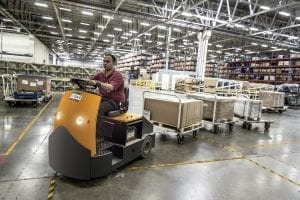The advantages that come with operating in an FTZ are beneficial to the growth of import and export globally. Primarily during times when tariffs are changing, and new foreign trade policies are implemented.
As a manufacturer, individual, or third-party logistics service provider, importing or exporting goods, there are benefits designed to lower or even avoid duties and tariffs when you utilize a Foreign-Trade Zone.
What are Foreign-Trade Zones (FTZ)?
Foreign-Trade Zones (FTZ) are specified areas outside or near-custom ports of entry in the United States, where goods are landed, handled, produced, reworked, repackaged, and re-exported free of custom rules and regulations. Though FTZs are considered to be outside the U.S. Custom and Border Protection (CBP) territories, they are, however, supervised by the U.S. CBP (Customs and Border Protection). The goods brought in via FTZs only become subject to prevailing custom duties when the goods are moved to consumers within the country.
The reduction of these formal custom regulations leads to an impressive turnaround for shipment for import-export businesses and their supply chains and also increases trade efficiency in eCommerce. For example, standard FTZs can provide storage on lease and distribution space in warehouse-type space suitable for online retailers. These spaces also enable import-export businesses to construct temporary facilities and manufacture products without having to pay high import fees.
Although outside the United States, FTZs are sometimes referred to as foreign, export, or free export processing zones and could slightly differ in meaning. The primary purpose of a foreign-trade zone is to remove from all port entries the obstacles to trade often caused by high tariffs and complex customs regulations among other advantages discussed below.
- Duty Deferral and Elimination
FTZs operate independently of customs requirements and laws. Thus this means that goods coming into FTZs do not incur duties until they exit the zone. From the time between import and export, a company or individual can defer or altogether eliminate duty expenses. At the same time, the raw material or finished product is reworked and repackaged to meet entry standards into the U.S. market, or for re-exportation. Also, duty deferrals on FTZs apply to any customs program, and it can exempt you from inventory tax and other taxes as well.

pashminu via Pixabay, www.pixabay.com
Additionally, there isn’t a limit on the length of time that goods may remain within an FTZ, unlike what is obtainable in warehouses that are bonded or under temporary importing programs. For example, if a flip-flops company ships in a container from Cambodia. There is no time limiting how long the cargo can sit in the FTZ. When the flip-flops are sold outside the U.S., the company can do so without having to pay U.S. import duties. If they are sold to retailers in the U.S., the tax will be paid when the product is sold and leaves the FTZ. Thus duty deferral helps the company better manage its cash flow.
- Inverted Tariff Relief
“Inverted Tariffs” is the effective penalty that U.S. manufacturers have to pay when importing materials to manufacture products in the U.S., and those products will likely be exported and sold in other countries. What Foreign-Trade Zones do in this situation is to make it easier to keep more of your brand’s manufacturing on U.S. soil without the effective penalty of Inverted Tariffs.
Most times, these parts are fined at a higher rate than the cost of the finished product, making it more cost-effective to manufacture outside the U.S.. Using an FTZ means you pay only the lowest duty needs and potentially eliminate the costs that come with importing raw materials.
- Weekly Entry Savings on Merchandise Processing Fees (MPF)
FTZ users only pay Merchandise Processing Fees (MPF) on goods going through the United States Customs territory. As opposed to filing an entry each time a shipment enters the U.S., when bringing in merchandise via a Foreign-Trade Zone, you only need to register one Customs entry a week. Weekly entry helps to reduce bureaucratic challenges and cost implications that arise with entry filings.
The MPF for each entry is charged at 0.3464% of the Total Estimated Value (TEV) of the merchandise, i.e., the fee ranges between $25 to $508 per entry, depending on the value of the goods and costs between $2 to $9 per shipment for an informal entry.
Therefore if an importer has ten shipments a week and each costs over $230,952, it means $226,980 can be saved annually using FTZ weekly entries. Another advantage of weekly entries is that you can also save on customs brokerage fees. Shipping your product into an FTZ will reduce the costs of filing custom entries, and fewer entry filings could amount to a reduced brokerage fee.
- Zone-to-Zone Transfers
The advantage of zone-to-zone transfer is that goods within a U.S.-based FTZ can be cross-docked to another FTZ in the U.S. without paying customs duties, and the benefits of FTZ will still be maintained. Take, for example, where a travel suitcase manufacturing company has 15 distribution centres across the U.S. They can move their products between Foreign-Trade Zones in the United States without having to pay any duties or Merchandise Processing Fees (MPF) until they are ready.
The added benefit of being able to transfer between FTZs comes in very handy for companies that manufacture large products such as boats, because most such companies need to import materials and transfer parts between manufacturing factories and distribution centres. With zone-to-zone transfers, materials and components are within close reach. Presently, a lot of top- to mid-level companies make use of cross shipping platforms to transfer goods to FTZs both within and outside the U.S.
- Improved Classification and Inventory Tracking
Free-Trade Zones enable the close tracking of goods imported and exported. Also, when products arrive at the FTZ warehouse that you control, you can easily take inventory, identify, and classify goods at the warehouse instead of at the port at a Customs control location.
The data required to classify goods are often voluminous, frequently change, and need to be pulled from country-specific lists. Thus this process needs a platform that automatically updates the information in a central repository. They can get such information from different systems, including import or export warehouse system management, and the necessary data for customs filing and inventory management.
Conclusion
The advantages that come with operating in an FTZ are beneficial to the growth of import and export globally. Primarily during times when tariffs are changing, and new foreign trade policies are implemented. To get the best of these benefits, companies need to consider using professionals like writing services review Best Writers Online to draft documents and also innovative and advanced technology such as data automation, smart logistics, delivery bots and drones, Blockchain, etc. to boost the supply chain of their businesses.


Join the conversation!